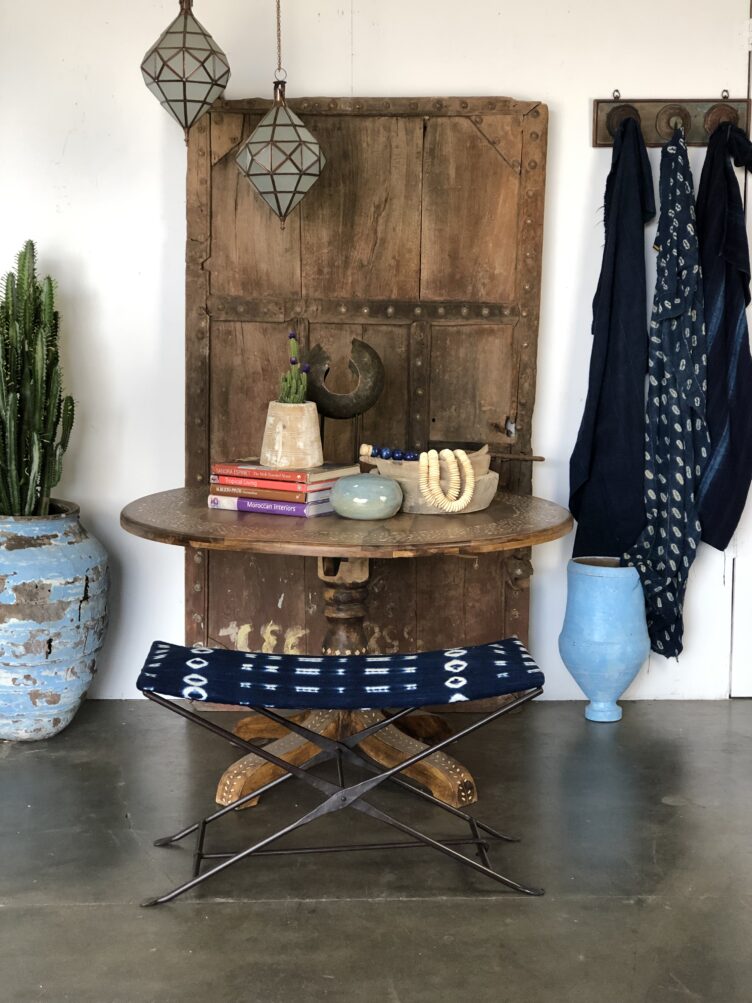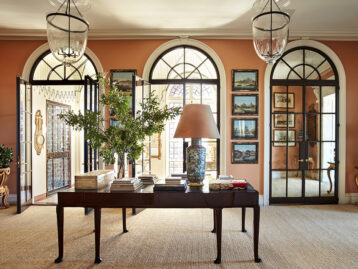Not many people can claim 50 years in the design industry and decades spent introducing Americans to new pieces they’d never seen from across the globe, but Suad Cano can. And she’s got the passport to prove it. The Iraqi-born owner of Berbere Imports worked for years as a social worker in East LA and Compton before using her skills in international relations and her passion for travel to launch her business. What started in a 50-square-foot showroom on Sunset Boulevard has morphed into a 40,000-square-foot powerhouse of the LA design scene, with everyone from AD100 talents to entertainment industry event planners and everyday consumers counted among their customers.
We spoke with Cano — who still does all of Berbere’s sourcing and buying, mind you — about the evolution of her business, what it was like launching her brand as a woman, and how the pandemic affected the world of global imports. Read about her fascinating story and be sure to shop all of Berbere Imports’ robust offering on Chairish.
Shop Berbere Imports
Product_id 2720746 not found
Product_id 3184986 not found
Product_id 3184960 not found

Your business began 50 years ago, with imported handmade Berbere rugs and Moroccan accessories in a very small showroom on Sunset Boulevard. Tell us about those early years and how you got your start.
I first started my business by bringing things back from trips for my friends. I seemed to have a knack for finding unique items. At some point, my little house quickly filled up, and so in the early 1970s, I decided to open my first shop. We called it “Berbere” because I had committed to a partial container of Berbere rugs, something that did not exist in Los Angeles. At that time, the only other rug dealers were Persian. They kept stopping by, asking about my rugs. Within a couple of years, those shops began importing Berbere rugs. Don’t let anyone tell you otherwise; I was the first to bring and sell Berbere rugs in California!
That first store was 50 square feet on Sunset and Vermont. To put it into perspective, the Pacific Design Center was still in the planning phase, and my neighbor was what they called a “Gentlemen’s Club.” We were only open on the weekends but found people were very interested in the rugs, and we quickly sold out. We were there for a few years until an opportunity opened up to move to a larger space on Robertson and Beverly. We focused almost exclusively on rugs, and for the next few years, began importing from other places like India and Afghanistan.
Interestingly enough, in 1979, I was in Afghanistan buying rugs when the Soviet invasion began. The military took over our hotel, and we had to stay with a family until they could smuggle us out of the country through Pakistan. In those days, it was just part of doing business!
Shop Berbere Imports
Product_id 3184979 not found

As a female business owner, how do you think things have evolved for women in the industry over the last 50 years? Or have they evolved?
It’s interesting. Things in the U.S. have changed the most, in my opinion. Back when I started Berbere Imports, the U.S. wasn’t very female-friendly. Banks didn’t want to lend you money, and places were hesitant to lease to you. The reverse was true in the places I was traveling to, like Afghanistan, Turkey, and Morocco. In those countries, I was negotiating with women and men alike. Men specifically loved to work with me. I was extended credit often, on a handshake alone. For example, I’d have enough to purchase $5,000 worth of rugs, but they would extend me $15,000 of credit. I’d make payments to them from California. Trust had nothing to do with whether I was a woman; it had to do with the fact that I honored my word. In the U.S., women and men are now more on par with one another, specifically in my industry. That certainly wasn’t the case in the late 1970s.
You have a 40,000-square-foot showroom space. Very simple question: How do you source and fill such a huge space?
After 50 years, you collect a lot, and you also build great relationships for repeat business. I’d say 20% of my warehouse is comprised of things accumulated over the years… one-of-a-kind and somewhat rare things that no longer exist. In contrast, the other 80% is what people want now. Items that we turn over and source readily due to relationships we’ve built with trade and artisan families over decades.
Shop Berbere Imports
Product_id 3181093 not found
Product_id 3181058 not found

Berbere Imports has a huge following among the design trade, including folks like Martyn Lawrence Bullard, Nicole Hollis, Sandra Espinet, and Cliff Fong. What kinds of things are designers, in particular, buying these days?
Top designers set trends. They identify and buy unique, highly functional things, whether it’s furniture or accessories, often handmade by artisans. These things become the items replicated by more prominent furnishing brands or are later custom made at a very high cost. They also only buy quality. Quality lasts.
On the opposite side of the coin, you also welcome design enthusiasts to Berbere Imports. What kinds of things do you see those clients buying, and how do you make sure they find what they’re looking for?
They are looking for things to make their home environments more livable and functional — things that have multiple purposes. For example, a vintage Turkish bread bowl can be used for food, hand towels, even plants. It can be moved from room to room, helping to recreate and repurpose spaces. Wabi-Sabi appears to be in right now. Perfection in the imperfection. Natural and light-colored wood and stone too.
Shop Berbere Imports
Product_id 3180931 not found
Product_id 3180967 not found
Product_id 3180926 not found

Have you seen more customers coming through digital methods like Chairish? Do you see that having an effect on how designers shop for vintage, in particular?
Absolutely. Chairish does a fantastic job of helping curate and direct people to exceptional items they otherwise wouldn’t find. We even use Chairish to see what other vintage items are available. That’s saying a lot because designers come to us for the same reason.
How have things evolved for the business over the last year, in particular, with the pandemic? Business is certainly in a different place than it was last spring… tell us a bit about your experience.
In March 2020, I landed in Los Angeles days before the lockdown after a month-long buying trip in Thailand and Indonesia (I was supposed to go to China and Vietnam as well). Having containers come in during COVID was critical to our business. We got lucky and had items when few others did. We’ve also been fortunate enough to remain open during COVID. Designers and the public were able to come to our large, very spacious facility, remain socially distant, and improve their living spaces. We were thrilled to be able to provide that service at a time when your immediate environment was all you saw for months on end.
Shop Berbere Imports
Product_id 3180973 not found
Product_id 3180943 not found
Product_id 3181007 not found

Have you seen a difference in the types of pieces that have been selling over the last year at Berbere Imports? What trends are you seeing?
Large vintage pots and vessels are big right now. I think people want to connect with something older, something of the earth, something that reminds them of permanence. Unusual things, one-of-a-kind items are also really in. Again, people appreciate quality and are looking for it.
Who are some of your favorite designers or design icons who inspire you?
You named some great ones above: all friends, all clients. If I mention anyone specifically, I’d have to mention 100 more as each has contributed to amazing design trends over the years. I wouldn’t want to leave anyone out! I’ve learned from them all and continue to learn daily.
What also inspires me is how fearless emerging new designers are. They integrate styles across the decades and have an excellent grasp on how otherwise disparate objects fit together in meaningful ways.
Shop Berbere Imports
Product_id 3180923 not found
Product_id 3180963 not found
Product_id 3181003 not found

Are there any dream pieces you’d love to own yourself someday?
I’ve been fortunate to collect what I love, so not many. That said, If I could find it again, I would buy more large vintage Chinese shop signs from the late 1800s and early 1900s. The one I have is hand-carved and hand-lacquered. What makes it remarkable is it contains poetic messaging, not simply saying “open for business.” Instead, it has messaging that welcomes and blesses you with statements incorporating such themes as spirit and love. Could you imagine if businesses did that today? Greeted you with a blessing?
When we’re all able to travel internationally again, what’s the first destination you’re going to visit?
I’m not too fond of things left unresolved. I’d go back and finish the trip I started right before COVID, beginning in China (Chengdu) for stone troughs and ending in Vietnam for all kinds of unique furnishings and accessories. After 50 years, I’m always ready to go and discover new things. My hobby became my life, and I couldn’t be happier.
Shop Berbere Imports
Product_id 2931307 not found
Product_id 2931092 not found
Product_id 2937795 not found
Product_id 2931098 not found
All images courtesy of Berbere Imports





















